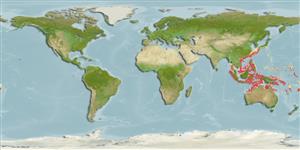Classification / Names
Common names from other countries
Main reference
Size / Weight / Age
Max length : 50.0 cm TL male/unsexed; (Ref. 5222)
Environment
Marine; reef-associated; depth range 80 - 130 m (Ref. 5222)
Climate / Range
Tropical, preferred ?; 35°N - 20°S, 95°E - 179°W (Ref. 5222)
Distribution
Western Pacific: Andaman Sea to southern Japan, Taiwan, China, Philippines, Viet Nam, Malaysia, Thailand, Indonesia, New Guinea, the Arafura Sea (Ref. 9819), northwestern Australia, and Fiji.
Countries | FAO areas | Ecosystems | Occurrences | Introductions
Short description
Dorsal
spines
(total): 11;
Dorsal
soft rays
(total): 15-16;
Anal
spines: 3;
Anal
soft rays: 8. Distinguished by the following characteristics: head, body and median fins are pale grey; 5 broad dark brown bars, first 2 extending into the spinous part of dorsal fin, 3rd and 4th bars extending into the soft dorsal and anal fins, 5th dark bar at the base of the caudal fin; edges of dorsal parts of body bars with small black spots; nape with dark brown saddle blotch, small black spots mainly along edge of the blotch; cheeks, snout, interorbital area, jaws and chest mostly dark brown, with 2-3 white bands radiating from the eye; irregular black bar on the middle of the caudal fin; yellow maxillary groove; body depth less than head length, 2.5-3.0 times in SL; head length 2.1-2.4 times in SL; rounded preopercle, 3-6 enlarged serrae at the angle; upper edge of operculum slightly convex; nostrils subequal or posterior nostril larger than anterior; scaly maxilla, reaching about vertical at rear edge of eye; 2 rows of teeth at midside of lower jaw; pectoral and pelvic fin length are equal, 1.7-2.3 times in head length; rounded caudal fin; ctenoid lateral body scales, few auxiliary scales in adults (Ref. 089707).
IUCN Red List Status (Ref. 115185)
Threat to humans
Harmless
Human uses
Fisheries: minor commercial
More information
ReferencesAquacultureAquaculture profileStrainsGeneticsAllele frequenciesHeritabilityDiseasesProcessingMass conversion
Tools
Special reports
Download XML
Internet sources
Estimates of some properties based on models
Phylogenetic diversity index
PD50 = 0.5000 many relatives (e.g. carps) 0.5 - 2.0 few relatives (e.g. lungfishes)
Trophic Level
3.8 ±0.6 se; Based on size and trophs of closest relatives
Resilience
Medium, minimum population doubling time 1.4 - 4.4 years (Preliminary K or Fecundity.)
Vulnerability
Moderate vulnerability (42 of 100)
Price category
